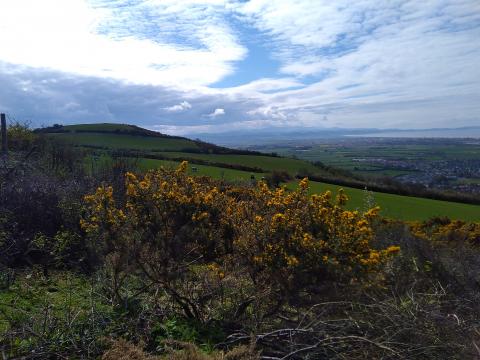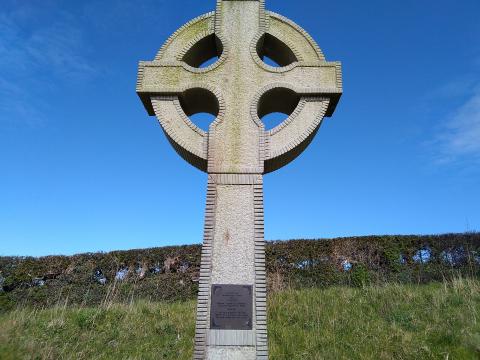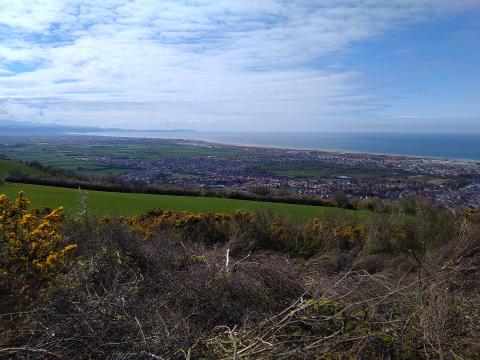Gwaenysgor: Christ saw Us

In-between my various lectures and seminars at Word Alive, I climbed the large hill over Prestatyn, which is the northern-most point of the Welsh Clwydian Range. Straddling the border of the counties of Denbighshire and Flintshire, the small village of Gwaenysgor lies at its summit, enjoying spectacular views of the Irish Sea, Lancashire (what a treat!) and the Welsh mountains. It is not the highest hill I have climbed at only 770 feet, but I found myself puffing and panting all the same. Had it something to do with the eat-all-you-can-eat Pontins breakfast and evening meal buffets I had been enjoying? Surely not. Towards the top was a large cross, conveniently located by the carpark for those even more hampered by the Pontins hospitality. Written upon a metal plaque was:
Eglwysi Yaghyd Yng Nghymru
Churches Together in Wales
Psalm 121
"I lift up my eyes to the hills Where does my help come from?
My help comes from the Lord."

Judging by some of the religious establishments in Prestatyn, the churches together in Wales probably do not amount to very much. I was grateful, however, for their having erected this symbol of faith and hope, even in its Celtic style. Jesus is said to have died on a hill (though the exact location of the crucifixion is disputed, with Gordon’s Calvary and the Sepulchre Church the best-known contenders), yet I cannot see anywhere in the text explicitly stating He was executed high-up. ‘Golgotha’ or Place of the Skull, if it is a rocky outcrop, was likely a raised area. His death was certainly a public spectacle, easily observed from those in the vicinity. Rome wished her victims’ fates to be a deterrent to any others who would defy her rule, so public deaths were very much desired. From a large hill, in both Welsh Wales or without the walls of Jerusalem, one can see much, and be seen by many. From that Welsh cross I could see far in three directions, and the people below could see me, had they the vision and desire to so do. The Lord Jesus was observed by onlookers, soldiers, disciples and mockers, but what and whom did He see? Far more than just those who were watching Him, I think. Writes Isaiah in 53:10:
Yet it pleased the Lord to bruise Him;
He has put Him to grief.
When You make His soul an offering for sin,
He shall see His seed, He shall prolong His days,
And the pleasure of the Lord shall prosper in His hand.
I believe this verse teaches that even while He was suffering and paying sin’s debt, He beheld with His eternal eye all those whom He would save, the many daughters and sons He would bring to glory. ‘Seed’ usually refers to one’s progeny; it refers to our status as adoptees into God’s family, who are become sons of God. Might the Lord Jesus, as well as paying for our sins, have seen each one of us, even yet unborn, while He hung there, dying? Had He seen us in our selfish, rebellious states, He might well have come off the cross and given up on a bad job. Rather, I think He saw what we would be as a result of His atoning death- justified, sanctified and glorified. He saw us as transformed people, converted, washed and conformed to His image. Just as we ‘see’ ourselves in the book of Revelation, praising God in song at the great and majestic finale, so the Lord Jesus beheld us from afar.
Your eyes saw my substance, being yet unformed.
And in Your book they all were written,
The days fashioned for me,
When as yet there were none of them. Psalm 139:16


- Log in to post comments


 Sunday Worship 10.45am & 6.00pm
Sunday Worship 10.45am & 6.00pm